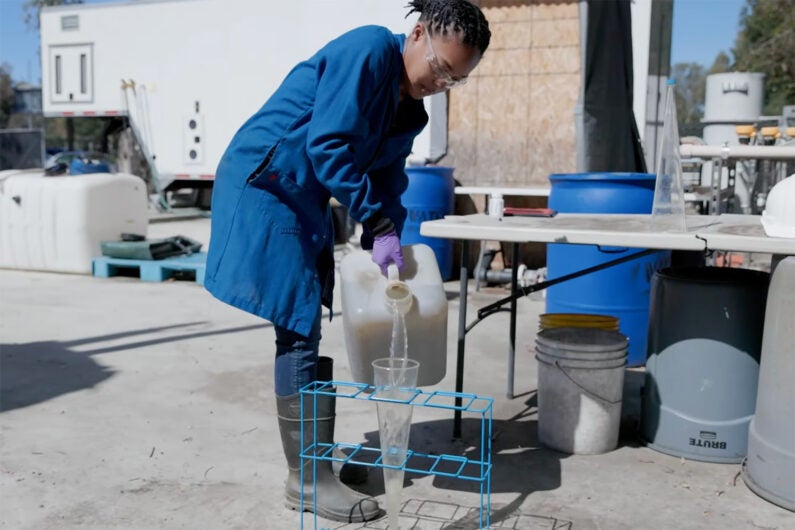Stanford-led WastewaterSCAN project adds six new disease targets ... - Stanford University News
Stanford-led WastewaterSCAN project adds six new disease targets
Pioneering epidemiology project WastewaterSCAN has added parainfluenza, rotavirus, adenovirus group F, enterovirus D68, Candida auris, and hepatitis A to the list of infectious diseases it can monitor for public health. Its monitoring roster already included COVID-19, RSV, Mpox, influenza A and B, human metapneumovirus (HMPV), and norovirus.

Stanford undergraduate Julia Simon collects wastewater from the Codiga Resource Recovery Center on the Stanford campus for analysis in 2022. (Image credit: Harry Gregory)
Stanford-led WastewaterSCAN project provides pioneering research in "wastewater-based epidemiology," the science of scanning small samples of sewage for viruses, microbes, and fungi that cause dangerous infectious diseases. In collaboration with Emory University and Verily Life Sciences, the project this week announced it has deployed assays for six new pathogens, bringing its total roster of disease targets to 12 of the most critical seasonal and emerging pathogens currently in the United States.
By providing timely and actionable data via its data dashboard, WastewaterSCAN enables health officials and communities to quickly spot disease patterns and trends so that they can make informed choices about how to respond.
"The inclusion of six new pathogens demonstrates the value of wastewater-based epidemiology as durable public health infrastructure," said Alexandria Boehm, professor of civil and environmental engineering at Stanford University and principal investigator and program director for WastewaterSCAN. "It is a significant milestone for WastewaterSCAN and wastewater-based epidemiology."
The new disease targets in WastewaterSCAN's roster include parainfluenza, rotavirus, adenovirus group F, enterovirus D68, Candida auris, and hepatitis A. With these additions, WastewaterSCAN now tracks three of the most significant gastrointestinal diseases in the U.S. and is the first wastewater-based epidemiology project to perform national-scale monitoring for enterovirus D68 and the multidrug-resistant fungus Candida auris.
WastewaterSCAN is also the first nationwide wastewater monitoring project in the U.S. to expand beyond SARS-CoV-2, the virus and variants that cause COVID-19, to track and publicly share data on RSV, Influenza A and B, mpox, norovirus, and human metapneumovirus. WastewaterSCAN now monitors 12 key respiratory, intestinal, and emerging infectious diseases, and one fungus that presents a significant public health threat. WastewaterSCAN selected the six additional pathogens through close conversations with its public health collaborators nationwide.
"By being nimble to known and emerging threats and quickly rolling out new disease targets, WastewaterSCAN has established a powerful weather report for infectious diseases," said Marlene Wolfe, assistant professor of environmental health at Emory University and program director of WastewaterSCAN. "Given the value of data, we hope to see support for wastewater monitoring continue to grow and more communities using this data to inform personal and collective responses to not just COVID-19, but also other diseases that are commonly a concern."
More about WastewaterSCAN
Throughout the pandemic, the science of studying sewage for the presence of disease – also known as wastewater-based epidemiology (WBE) – has drawn increasing attention from public health, government, local officials, and wastewater treatment plants. WastewaterSCAN is already working with municipal wastewater treatment facilities in more than 180 communities across 37 states in the U.S., monitoring wastewater for COVID-19, seasonal flu, RSV, and numerous other viruses. Those communities are home to almost 42 million Americans – 12% of the U.S. population. The approach tests everyone in a community but cannot identify any specific individual. As an academic project funded philanthropically, WastewaterSCAN covers the full cost of wastewater monitoring to participating communities, including sampling, shipping, and data availability.
Taking small samples from each wastewater treatment plant up to three times a week, WastewaterSCAN monitors for the presence of disease in its collaborating communities, detecting the prevalence of pathogens often before citizens show symptoms or seek medical attention. This early warning system helps public health and government officials assess the relative presence of disease in their community – whether infections are rising, falling, or remaining the same. Ultimately, WastewaterSCAN helps those officials make better, more fully informed decisions about when and how to act for the benefit of the community.
WastewaterSCAN also reports data through the National Wastewater Surveillance System, the CDC's effort to coordinate tracking of SARS-CoV-2 in wastewater samples collected across the country. WastewaterSCAN's protocols and approaches are published online and are open source, and academic papers are available on its website.
More about the six new assays WastewaterSCAN has added:
- Parainfluenza – Causes respiratory infections with cold-like symptoms in infants, young children, older adults, and people with compromised immune systems but can lead to more serious lung infections and breathing difficulties.
- Rotavirus – Highly contagious and often affecting unvaccinated children 3-5 years of age causing diarrhea, vomiting, fever, and abdominal pain.
- Adenovirus group F – Leads to acute gastroenteritis causing fever, diarrhea, vomiting, and abdominal pain. In rare instances, cases can turn severe, with people who are immunocompromised or have existing respiratory or cardiac disease more susceptible to the virus.
- Enterovirus D68 – A common non-polio enterovirus causing respiratory illness – runny nose, sneezing, coughing, and body aches. Severe cases may cause wheezing and difficulty breathing. Infants, children, and teenagers are most susceptible.
- Candida auris – An often-drug-resistant yeast that causes severe illness and, in rare cases, death. auris is easily transmitted among high-risk patients in health care settings. Treatment is possible, but there are now drug-resistant strains of the fungus.
- Hepatitis A – Highly contagious, viral infection of the liver. Symptoms include tiredness and weakness, sudden nausea and diarrhea, abdominal pain, loss of appetite, and low-grade fever. Can be spread asymptomatically.
"The broadened suite of diseases that WastewaterSCAN tracks for communities and public health officials shows how useful wastewater monitoring can be as a public health tool at the local, state, and federal levels," added Boehm. "This can help inform decision-making in areas like biosecurity and emerging infectious disease threats."
Comments
Post a Comment